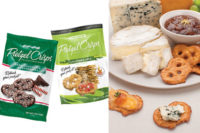![]()
Producing the Perfect Patty
by Martin Schultz
Somewhere on the way from Jamaica to the Bronx and then to the New York suburbs, a Caribbean immigrant figured out the secret recipe for…
Catch a glimpse of Caribbean Food Delights’ (CFD) sign, and you’ll soon be dreaming of a beachfront chalet surrounded by palm trees, blue sky and gently lapping waves. That’s the fantasy.
In reality, the 26-year-old company operates a state-of-the-art food-production plant on Route 303 among the green hills of Tappan, N.Y., where it conducts the serious business of manufacturing savory Jamaican patties, which are similar to baked turnovers.
Still, the fantasy world of the Caribbean manages to intrude on the business world of a New York suburb. Staring out from photos lining the walls are a smiling governor general of Jamaica and the prime minister of the island nation. They are giving out awards honoring Vincent HoSang, founder of CFD, for supporting his Jamaican homeland and heritage.
Other wall décor includes framed certificates from various leaders honoring HoSang, including the honorable consul general of Jamaica, Dr. Basil K. Bryan. Another is from the borough president of Brooklyn, N.Y., for HoSang’s generous support of community organizations. Still another is a city of New York proclamation honoring Jamaica’s 40th year of independence and HoSang’s role in promoting the island. Then there’s the embossed certificate from the Republican National Committee proclaiming HoSang as Businessman of the Year for 2002 and 2003.
It’s been a long journey from the days when the almost-penniless HoSang emigrated to New York to earn $49 a week assembling briefcases in a factory in the Bronx.
Today, HoSang is the president and CEO of what he claims to be the world’s largest Jamaican frozen food plant, which operates in a 73,000-sq.-ft. located on 10 acres. Since its inception in 1980, CFD has operated on the theory that “if you focus all of your attention on making a consistently good product that looks appetizing and tastes authentic, you will sell all you can produce and more.”
That theory has proved to be a good business strategy, judging by the sales figures, which topped $25 million in 2003. Because of overwhelming demand, CFD will be offering franchise opportunities the latter part of this year.
Initially, in February 1978, HoSang and his wife, Jeanette, bought the “Kingsbridge Delight” fast-food fried chicken store in the West Bronx and added Jamaican cuisine such as oxtail, curry goat and beef patties. In 1980, they acquired a small bakery, also in the Bronx, and named it Royal Caribbean Bakery.
By offering quality products and service, they soon increased business to the point where they outgrew the facility, and expanded into a 15,000-sq.-ft. plant in 1984. In 1987, Royal Caribbean Bakery and CFD expanded once again, this time into a 20,000-sq.-ft facility in Mt. Vernon, N.Y. Business continued to grow, and six years later HoSang bought the 73,000-sq.-ft. facility in Tappan, N.Y., that became the corporate headquarters and manufacturing center for CFD.
“From the beginning we had two objectives. One was to produce consistently high-quality Jamaican food products and the other was to be able to wholesale and introduce [them] to the mainstream market,” HoSang says.
To reinforce his first point, HoSang recalls that he learned several lessons from purchasing that first take-out restaurant in the West Bronx, which sold fried chicken, shrimp, ribs and french fries, along with other items.
“By improving the methods the former owner used to prepare the meals,” he says, he applied “the concept that consistency of product quality entails maintaining the same routine throughout the production process.”
Everything had to be carefully planned and closely monitored — from equipment purchase to ingredient selection through all the steps involved in finished-product production.
“Each investment that we made, from the fried chicken store to the retail bakery and then to the production plant, taught us lessons we put to use with the next investment,” HoSang says. “It was all part of the learning process.”
The Heart of the Operation
At the heart of CFD’s operation are the meat, chicken and vegetable patties, also known as empanadas to Hispanics and a turnover to everyone else. The Jamaican meat patty, however, has several unique qualities that make it a favorite of the Jamaican and Caribbean populations, as well as more and more Wal-Mart and Costco shoppers, among others, willing to try this delicious specialty food.
For a start, CFD uses only high-quality ground beef to which authentic Jamaican spices and other seasonings are added. The filling then is pumped into the dough, which is mixed with vegetable shortening. Combined, these ingredients give the patty its distinctive flavor and flaky crust. Finally, the patty is packaged in a colorfully printed box that shows the portable product in all its mouthwatering glory.
As HoSang notes: “First you buy with your eyes, then with taste.”
As HoSang notes: “First you buy with your eyes, then with taste.”
With two lines operating on a single eight-hour shift, CFD pumps out 30,000 4.5-oz. patties or 58,000 1.5-oz. cocktail patties an hour.
“Although the spicy beef patty is our No. 1 seller,” HoSang explains, “we have created eight varieties to heighten the interest of the consumer.”
Starting with the beef patty, CFD developed two versions, mild and spicy. Then the company introduced a chicken variety, again in two versions, curry and jerk. Now the brand has been extended to include vegetable, shrimp, soy and callaloo patties. (For the uninitiated, callaloo is a leafy green vegetable that is similar to spinach.)
The retail pack patties are packed two, three, eight or nine to a box and come with a variety of serving suggestions. CFD suggests, for example, taking an a la carte approach, with just a glass of milk. Other suggested alternatives include placing a patty on a bun such as coco bread, and serving it as an entrée with french fries, tomato and lettuce. The company also produces a foodservice pack, which contains 50 patties for restaurants, hotels, schools and prisons.
Although the Jamaican patty is now popular with Jamaican and non-ethnic consumers alike, success did not happen overnight. HoSang confronted some challenges along the way. For example, he discovered he could not open a wholesale operation without obtaining the prior approval from the U.S. Department of Agriculture (USDA).
“This meant we would have to construct our facility and operate under strict USDA regulations and provide an on-site office for the USDA inspector,” he says.
CFD now has highly qualified research and development and quality assurance personnel with the right kind of food-handling expertise with several employees certified in Hazard Analysis Critical Control Point (HACCP) and bioterrorism food security.
The Tappan plant produces all frozen products — the patties, jerk chicken and wings, frozen entrees and more. Meanwhile, the Mount Vernon plant produces bakery products such as hard dough bread, Easter buns, cakes and pastries. In addition, Mount Vernon functions as the principal distribution center for all production. Each day, a trailer load of patties leaves Tappan and heads for Mount Vernon.
One side effect of CFD’s surging success is that the company has run out of freezer space and must use outside cold storage.
“Currently, our freezer has enough capacity for 10 trailer loads, and we are in the process of adding an additional freezer which has the capacity of another 25 trailer loads,” HoSang says. Additionally, CFD is planning a $10 million expansion by adding an additional 22,000 sq. ft. of production area to be completed by 2006.
“My objective,” says Timothy Conway, director of sales and marketing, “is to develop a strategic plan to move our ethnic products into the mainstream marketplace.”
Foodservice and restaurants account for 65% of the company’s business, with retail, mainly warehouse clubs, making up the 35% balance.
“What Mr. HoSang wanted when he hired me away from a big food corporation was a big corporate marketing strategy,” Conway says. “What we needed to do was to expand into the mainstream marketplace, essentially by redefining our core customer, so that we’re no longer just a West Indian product.”
The success of this strategy can be seen in the company’s strong penetration of several national retailers. For example, CFD has national distribution in Wal-Mart and Sam’s Club stores, as well as a strong presence in Costco, BJ’s and Stop & Shop locations.
Even more important, the company has enlarged its presence in these store chains. Since 2001, CFD has increased its sales in mass market channels by 72% and in club stores by 42%.
“Our plan is to move from our present $25 million level in sales to $100 million within five years,” Conway explains. “This means increasing our distribution nationally along with the franchise offering.
“Once a consumer has tried our patty,” he adds, “they’ll like it and keep on buying. But where we get resistance is sometimes from buyers who are not familiar with this product. The buyer’s view is: ‘Why should we buy these products when none of our consumers even knows what they are?’ But the customers do know. Most vacationers who take a vacation to Jamaica come back having tried and loved the patties. And they’ll tell many of their friends.”
Ethnic food of all kinds is incredibly popular these days, Conway says. Many of CFD’s retail customers are looking for specialty products.
On the marketing level, CFD will be advertising to a mainstream audience, with ads in both the New York Times and the Wall Street Journal.
“In these ads, we’re positioning the patty as a very simple product that is high [in] quality, relatively easy to prepare and inexpensive,” Conway says. “All we would like people to do is to give it a try. When they do, they’re hooked.”
But as HoSang knows all too well, if you want to hook the consumer, you first have to produce a product they’ll want.
Baking up Hot Patties
CFD’s absolute insistence on product consistency becomes immediately apparent the moment a visitor walks into the plant. All ingredients needed for each day’s production, from spices to beef, are pre-weighed and prepared for use. For example, each batch of beef to be used that day is ground and stored in the refrigeration room ready for use. In the refrigeration room, the beef is set up on the first-in, first-out principle. When the next batch of beef is needed, an employee simply moves the tub that is next in line and transfers it to the kettle for cooking.
This process is deliberately designed to ensure employees take a step-by-step approach to production. Of course, nothing is 100% foolproof, but the simplicity of this method, combined with the rigorous continuous training every employee receives, helps to minimize the chance of mistakes.
“Mistakes can be very costly,” HoSang notes. As a result, CFD takes additional steps to ensure its high quality standards are met.
Production starts with pre-mixing. The company’s flour silo, with an 80,000-lb. capacity, receives a trailer load of ingredients weekly.
In the pre-mixing stage, flour passes through an automatic sifter before it is transported to the hopper. The pre-scaled ingredients are then added to the mix.
The entire batch goes into a stainless steel mixer. In fact, almost all of the equipment CFD uses is stainless steel, one of the many examples of the company meeting or exceeding USDA requirements.
After the batch is fully mixed, it is automatically transferred to a hopper on a sheeting line. The dough then passes through a series of rollers, which sheets it out into the required thickness.
The filling is cooked above the USDA’s required minimum temperature of 155°F, cooled, then automatically pumped onto the dough.
With cooking and cooling complete, the filling transfers to a depositor. As the dough sheet passes beneath, a pre-scaled quantity of filling is deposited. As the filling is deposited, the dough is folded over and crimped to form a closed and sealed patty.
At this point, the patties may either be flash frozen unbaked or baked first then flash frozen. The patties exit the blast freezer and pass through a metal detector and then on to packaging.
For foodservice accounts, employees pack the patties in a 50-count case, and each case is stamped with a lot number, production time and date and expiration date. The cases then are stacked and transferred to the freezer. On average, between 50% and 60% of the product staged in the freezer is earmarked for delivery either the same day or the following morning.
“We use a temperature-tracking device to monitor the products’ temperature inside the truck’s freezer compartment during the journey from plant to customer. This is one of the many steps we take to ensure that the integrity of the product is maintained,” explained Sabrina HoSang, director of operations.
The company’s future plans also involve exporting Jamaican food products to Europe.
The franchise operation, which is planned to begin by the end of this year, revolves around CFD’s concept of establishing restaurants and then servicing their food product needs.
“Each franchisee will undergo intensive training on all [aspects of] restaurant operation,” Vincent HoSang says.
CFD likes the franchise concept because it will give the company yet another channel of distribution for its products. Additionally, it will help bring awareness of the food from the Caribbean to mainstream America.
“We will be offering breakfast, lunch and dinner as we are presently doing in our current retail locations,” HoSang notes.
He frequently has been asked why he has not offered franchises sooner. His answer always has been that he did not want to put a franchise amongst the many loyal customers who have been supporting him for the past 26 years. However, many of those customers now are among those interested in becoming a CFD franchisee. HoSang is pleased fulfill their requests.
It will certainly be a delight to see CFD move to the next level.
It will certainly be a delight to see CFD move to the next level.
At a Glance
Company: Caribbean Food Delights, Inc., a division of Royal Caribbean Bakery, Inc.
Headquarters: Tappan, N.Y.
Brand: Caribbean Food Delights
Products: Jamaican beef patties, jerk chicken patties, vegetable patties, shrimp patties and soy patties
Plants: 73,000-sq.-ft. Tappan plant (site of SF&WB’s visit), produces the patties. A 20,000-sq.-ft. plant in Mount Vernon, N.Y., outputs bread, buns, cakes and pastries.
No. of Lines: 2 in Tappan, N.Y.
No. of Employees: 110 total in both facilities
2003 Sales: $25 million
Key Personnel
Pres. and CEO: Vincent HoSang
Dir. of Operations: Sabrina HoSang
Dir. of Engineering: Damian HoSang
Dir. of Sales & Marketing: Timothy Conway
Food Technologist: Simone HoSang
Headquarters: Tappan, N.Y.
Brand: Caribbean Food Delights
Products: Jamaican beef patties, jerk chicken patties, vegetable patties, shrimp patties and soy patties
Plants: 73,000-sq.-ft. Tappan plant (site of SF&WB’s visit), produces the patties. A 20,000-sq.-ft. plant in Mount Vernon, N.Y., outputs bread, buns, cakes and pastries.
No. of Lines: 2 in Tappan, N.Y.
No. of Employees: 110 total in both facilities
2003 Sales: $25 million
Key Personnel
Pres. and CEO: Vincent HoSang
Dir. of Operations: Sabrina HoSang
Dir. of Engineering: Damian HoSang
Dir. of Sales & Marketing: Timothy Conway
Food Technologist: Simone HoSang





